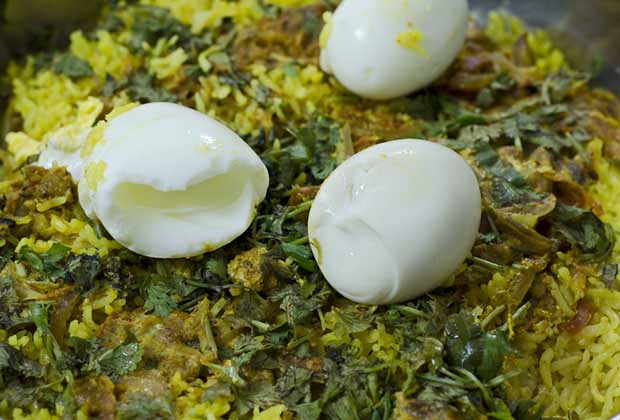Hunt For The Perfect Biryani In Chennai
- By Sumitra NairLoading...
- | 22 Nov 2016 11:11 AM GMT
 X
X
 Chennai boasts of a variety of biryanis. Photo: Dreamstime
Chennai boasts of a variety of biryanis. Photo: Dreamstime
When you talk about biryani, the usual types that pop up in any conversation are Hyderabadi, Lucknawi or the one from Kolkata. Chennai rarely comes into the picture. Although hard to believe, Chennai biryani is quite popular too. Proof is north Indians who travel here for work, take a liking to this variety of biryani that is milder in spices, and has a tomato-onion punch to it.
Love at first bite
The love for Chennai biryani began, when, on Saturdays, I would get a plate packed before heading to meet my fiancé. I'd usually buy it from the street corner near my apartment at Choolaimedu. Although it qualified as street food, the quality and flavours were spot on. On digging deeper, I realised that this delicious discovery was called Rawther biryani.
The recipe is an adaptation of the Persian biryani prepared by the Rawther Muslims of Tamil Nadu. Cooked with either lamb or chicken, it uses jeera samba rice, which unlike basmati has no inherent flavour or fragrance. Originated in Coimbatore, the biryani’s distinctive flavour comes from the use of ripe tomatoes and mint leaves that are cooked with spices and mixed with rice and shallow fried meat.
The non-dum biryani
The Rawther biryani is usually topped with a boiled egg, fried South Indian papad and kaichar or a thick gravy made from brinjal and dal. Though whole spices are used in making the biryani, it is ground and mixed with the gravy rather than left whole like in other biryanis. The dish is cooked more like a pulao as it is neither layered nor given a dum. Apparently this easier style of cooking biryani became popular with the Rawthers, who were traders, and found the dum method to be cumbersome during travel.
You can find some great Rawther biryani at the many Chennai Rawther biryani outlets across the city. One could also head to Ya Mohideen Biryani at Pallavaram or Hotel Kalyana Bhavan at Egmore or Star Biryani at a street corner at Choolaimedu. The price starts at Rs. 120 for a chicken biryani.
Born from a legacy
Chennai is also known for its Ambur biryani. The former originated, as the name suggests, from a town called Ambur on the Chennai-Bangalore highway. People in this town are known to eat biryani for breakfast!
The recipe is said to belong to Hasin Baig, who used to cook for the Arcot Nawabs. He created his own version of the Persian original for the Nawabs. The combination of tomato-onion gravy altered with curd for layering meat and seeraga samba or jeera samba makes the Ambur biryani so distinct. The meat, mainly mutton is first cooked in a combination of whole and ground spices, while the rice is cooked al dente. The biryani is then assembled and given a dum with charcoal sitting on the lid of the vessel.
The biryani is served with kathrikai pachidi or brinjals cooked in a thick tamarind gravy. It is not a surprise to know that Baig’s descendants have a chain of restaurants called the Ambur Star Biryani that serve this 110-year-old dish. Of course, the best Ambur biryani is to be found at Ambur Star outlets across the city. Prices starts from Rs. 110 for a vegetarian biryani to Rs. 170 for a mutton biryani.
Trademark worthy
Yet another biryani Tamil Nadu is famous for is, the Thalpakattu biryani. This too originated from a family secret recipe - like all the best ones do. The name Thalpakattu comes from the turbans or the headgear worn by the men in the family. This type of biryani came to being in the Naidu household from the district of Dindugal.
The story goes something like this. Nagaswamy Naidu from Dindugal was known for running a betel nut shop. His wife had this unique recipe for making biryani that was quite popular in the town. He decided to capitalise it and started a small restaurant back in 1957. The meat used for the biryanis would always be from grass-fed goats. This biryani too, is made from jeera samba rice and uses a combination of whole and ground spices.
The meat in this variant is first cooked in ground spices before mixing it with the rice. The recipe has no tomatoes, but an onion and curd-based gravy. Instead of being put on dum, the biryani is cooked on a low flame for 10 minutes and rested with its lid shut for 20 minutes. The resting period is very important. This particular biryani got into a copyright controversy, when the Rawthers released their version of the dish and called it Thalpakattu Rawther biryani. According to the High court ruling in April 2013, the Rawthers may only use the turban symbol, but not the name.
Lip-smacking Thalpakattu biryani can be found at all Dindugul Thalpakattu outlets across the city. The price starts from Rs. 160 for an egg biryani to Rs. 2500 for a bucket of mutton biryani that can serve 12 to 15 people.
Battle of the biryanis
My favourite biryani has to be the Rawther biryani as it is comparatively easy to cook and can be easily whipped up on a Sunday afternoon or when guests come in unannounced.
The author is based in Kochi and is a former journalist on a sabbatical, who is trying to find her writing voice. Her blog Bombay, Beatles, Bharatanatyam is inspired from the fact that all three have had a role in shaping the person she is.




